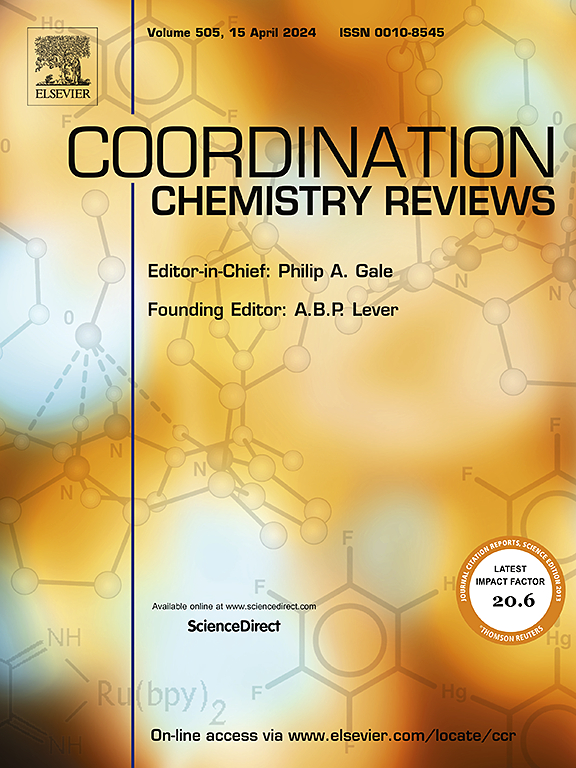Metal oxide semiconductor-based heterojunctions synthesized by wet-chemical strategies for efficient volatile organic compounds detection
IF 20.3
1区 化学
Q1 CHEMISTRY, INORGANIC & NUCLEAR
引用次数: 0
Abstract
Metal oxide semiconductor (MOS)-based chemiresistive sensors have been widely applied in indoor air quality detection, medical diagnostics, and environmental monitoring, and they also hold promise for future applications in agricultural product quality assessment. Developing sensitive materials with enhanced stability, humidity resistance, and high selectivity toward specific gases has become a key focus for their application in complex environments. Among these efforts, the construction of optimized heterostructures has gained significant attention and seen substantial progress in recent years, driven by advancements in material characterization techniques, electrochemical research, and the growing use of Density Functional Theory (DFT) calculations. Nevertheless, few reviews offer a comprehensive overview of heterostructure types and a clear explanation of their wet-chemical synthesis principles and sensitization mechanisms. Reviewing research papers published between 2020 and 2025, this work focuses on MOS-based composite materials constructed by various wet-chemical technologies for monitoring volatile organic compounds (VOCs). It categorizes three representative types of heterostructures—uniform distribution type, surface-loaded type, and core-shell type—based on the distribution of the second phases. It offers a comprehensive analysis and summary of the construction strategies for each configuration, the charge exchange between materials and gas molecules, electron transport within and between materials, and potential sensitization effects. On this basis, a comparative analysis identifies the key points for designing each configuration, the gaps in current research and achievements, and the potential focus for future investigation. This review aims to provide guidance for synthesizing highly efficient sensitized heterostructure materials.

湿化学策略合成的金属氧化物半导体异质结用于挥发性有机化合物的高效检测
基于金属氧化物半导体(MOS)的化学电阻式传感器已被广泛应用于室内空气质量检测、医疗诊断和环境监测领域,未来也有望应用于农产品质量评估。开发具有更高的稳定性、抗潮湿性和对特定气体的高选择性的灵敏材料已成为其在复杂环境中应用的重点。近年来,在材料表征技术、电化学研究以及密度泛函理论(DFT)计算日益广泛应用的推动下,优化异质结构的构建受到了极大关注,并取得了长足进展。然而,很少有综述能对异质结构类型进行全面概述,并对其湿化学合成原理和敏化机制做出清晰解释。本研究综述了 2020 年至 2025 年间发表的研究论文,重点关注通过各种湿化学技术构建的基于 MOS 的复合材料,用于监测挥发性有机化合物 (VOC)。根据第二相的分布情况,将异质结构分为三种具有代表性的类型--均匀分布型、表面负载型和核壳型。报告全面分析和总结了每种构型的构建策略、材料与气体分子之间的电荷交换、材料内部和材料之间的电子传输以及潜在的敏化效应。在此基础上,通过比较分析,确定了每种构型的设计要点、当前研究和成果的差距以及未来研究的潜在重点。本综述旨在为合成高效敏化异质结构材料提供指导。
本文章由计算机程序翻译,如有差异,请以英文原文为准。
求助全文
约1分钟内获得全文
求助全文
来源期刊

Coordination Chemistry Reviews
化学-无机化学与核化学
CiteScore
34.30
自引率
5.30%
发文量
457
审稿时长
54 days
期刊介绍:
Coordination Chemistry Reviews offers rapid publication of review articles on current and significant topics in coordination chemistry, encompassing organometallic, supramolecular, theoretical, and bioinorganic chemistry. It also covers catalysis, materials chemistry, and metal-organic frameworks from a coordination chemistry perspective. Reviews summarize recent developments or discuss specific techniques, welcoming contributions from both established and emerging researchers.
The journal releases special issues on timely subjects, including those featuring contributions from specific regions or conferences. Occasional full-length book articles are also featured. Additionally, special volumes cover annual reviews of main group chemistry, transition metal group chemistry, and organometallic chemistry. These comprehensive reviews are vital resources for those engaged in coordination chemistry, further establishing Coordination Chemistry Reviews as a hub for insightful surveys in inorganic and physical inorganic chemistry.
 求助内容:
求助内容: 应助结果提醒方式:
应助结果提醒方式:


